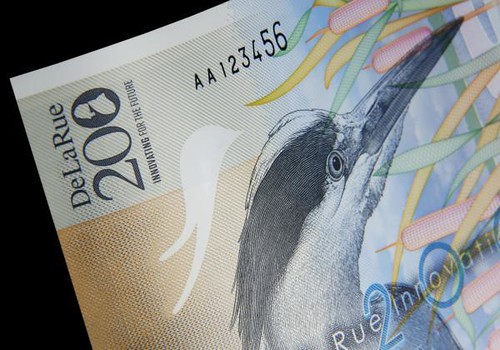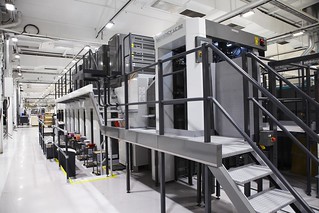
PREV ARTICLE
NEXT ARTICLE
FULL ISSUE
PREV FULL ISSUE
A VISIT TO BANKNOTE PRINTER DE LA RUEA reporter for the local newspaper The Northern Echo arranged a visit
inside a banknote factory owned by the secretive De La Rue company. Here's an excerpt, but
check out the complete article online. -Editor
Sitting a few hundred yards from Retail World on Team Valley is the largest commercial banknote factory in the world. It’s all bit hush-hush. I can only tell you a fraction of what I saw when I was given a rare glimpse inside De La Rue – the North-East factory with a licence to print money. This year the Gateshead plant marks its half century. Nearly 600 people work here, about two thirds of them in the banknote facility that converts blank sheets of paper into dinars, dollars and much more. The company, which traces its roots back 201 years to Thomas de la Rue’s London straw hat shop, has won scores of awards for its quality and innovation. The Gateshead factory, which has a sister plant in Debden, Essex, makes about ten million banknotes a day – up to 3.1 billion a year. Each note possesses a unique serial number and is produced to the most exacting standards. This year alone the firm's North-East will make 75 different denominations for clients across the world. 
A dummy house note showing the firm's printing and design skills We often talk about firms in our region being hidden gems. It is part of a business reporter’s job to shout about the great companies that often go unnoticed. For obvious reasons, De La Rue is about as low profile as a Stock Exchange-listed company can be. Securing access to this place was no mean feat. Getting a job here is nearly as tough as joining MI5. Background checks on job applicants are so detailed it means the recruitment process for production line staff can take up to eight months. Once people secure a job here they are advised to talk as little as possible about their workplace, and are even encouraged to come up with the name of an alternative employer to tell friends or family. One worker tells me that he had led his children to believe he worked for Pyrex, which was fine until the glassmaker went bust and his kids fretted that dad was headed for the dole queue. Security here is Fort Knox tight. Again, I can’t disclose much detail, but it’s safe to say that the typical factory visits I’ve been on don’t require multiple body searches. I’m allowed inside only after I’ve produced my passport, emptied pockets, had my photograph taken and gone through a series of security gates where more ID checks are taken. The first thing you notice inside the plant is the light. It’s a gloomy early autumn day outside, but the factory floor is as bright as an operating theatre. Being able to spot potential flaws before the production process goes too far can save the company a small fortune. It’s warm too – unusually so for a factory – as the air conditioning is set precisely to match the air temperature of the factory where De La Rue makes its paper. This prevents the sheets from shrinking or warping. Away from the main production area are small side rooms – one contains washing machines testing the durability of notes left in the pockets of jeans – while another is an oasis of calm where craftsmen tap away to remove tiny blemishes from the surface of the metal printing plates that bear the notes’ original image. We pass a printer churning out this year’s Christmas stamps, and head to the end of the production line where finished blocks paper, now worth thousands of pounds, are being fed into a guillotine, before being stacked on pallets awaiting dispatch. Bound into bundles they suddenly look less exotic, more real. The people who will use them will probably never give the details on the notes a second glance. They will barely notice that the grain on one side is more pronounced, or that the ink on a note fresh from a cash dispenser will smudge if rubbed hard enough. They certainly won’t think about Gateshead. But they should. To read the complete article, see:
Wayne Homren, Editor The Numismatic Bibliomania Society is a non-profit organization promoting numismatic literature. See our web site at coinbooks.org. To submit items for publication in The E-Sylum, write to the Editor at this address: whomren@gmail.com To subscribe go to: https://my.binhost.com/lists/listinfo/esylum All Rights Reserved. NBS Home Page Contact the NBS webmaster 
|
